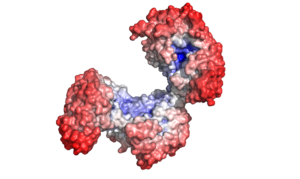Applicant
Prof. Dr. G. Greiner
Computer Graphics Group (Informatik 9)
FAU Erlangen-Nürnberg
Project Summary

The solvation free energy is important in drug design and similar problems. Since electrostatic contributions to free energy differences between multiple states, like structural ensembles from a crystal structure (CC/PBSA), are difficult to determine due to sampling problems, solving the Poisson-Boltzmann- Equation is an important step in these computations. This numerical approach already gives a considerable speed-up compared to atomistic models, but even more efficient implementations are desirable due to the amount of structures that have to be computed.
In our work we parallelized several steps of our previous implementation, like the generation of the molecular surface, the linear iterations to compute the electrostatic potential and the energy calculation itself, using OpenMP halving computation times. Further optimizations generated an additional speed up around 30%. Additionally, we carved out the influence of membranes in potential computations.
The possibility to directly work with Gromacs run input files (’.tpr’), that contain the system topology, coordinates, charges and atom radii, facilitates the use and makes it possible to integrate it directly into a CC/PBSA pipeline.

